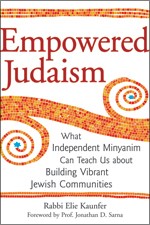 Is it just me, or are congregations around the country all of a sudden (or maybe not all of a sudden) waking up and realizing they’re missing a whole age group? As a twenty-something, I’ve been asked multiple times in the past couple of years to share my thoughts with Jewish institutions – and not because they necessarily want a broad cross-section of Jewish backgrounds, but because I’m a JYA: Jewish Young Adult, and they’re looking for guidance on how best to reach us.
Is it just me, or are congregations around the country all of a sudden (or maybe not all of a sudden) waking up and realizing they’re missing a whole age group? As a twenty-something, I’ve been asked multiple times in the past couple of years to share my thoughts with Jewish institutions – and not because they necessarily want a broad cross-section of Jewish backgrounds, but because I’m a JYA: Jewish Young Adult, and they’re looking for guidance on how best to reach us.
A generation ago, the majority of our age group was married and having babies by the time they were 25. There wasn’t a need to “figure us out.” We were there, just like the generations before. Today, the average age we get married is our late-twenties, and we’re waiting even longer after that to have kids – if we have them at all. With many temples doing an exceptional job catering to families with young and teenage kids, it left a void for those of us not yet in that demographic. But Rabbi Kaufner puts it best: “The real crisis is one of meaning and engagement. For the first time in two centuries, two Jewish adults can marry each other and have Jewish children without any connection to Jewish history, wisdom, or tradition.”
Addressing how to build a community that serves a demographic like ours – young, currently-unaffiliated, Jewish adults – is one of the central themes of Rabbi Elie Kaufner’s book, Empowered Judaism: What Independent Minyanim Can Teach Us about Building Vibrant Jewish Communities (Jewish Lights/May 2010/Paperback $18.99). According to Kaufner, “‘Empowered Judaism’ is a Judaism in which people begin to take responsibility for creating Jewish community, without waiting on the sidelines.” The minyanim he studied offer innovative approaches to spirituality, serious Jewish learning, gender inclusiveness, and flexible leadership models, all to build a greater connection to ourselves and our heritage.
A minyan usually means “a quorum of Jewish adults so prayers can be said within a temple’s congregation;” however, an “independent minyan” typically means a group of like-minded people outside the normal synagogue structure who pray and build some kind of community together. They may or may not have a rabbi (usually not), and almost never have staff people; they are led almost entirely by lay-leadership. Kaufner explores some of the most successful minyanim across the United States to see what we as the broader Jewish population can learn. Maybe we’ll start our own independent minyan, or maybe we’ll use it to re-energize our current synagogue, or maybe – just maybe – apply it in a way that gets us Jewish Young Adults back to temple – but without the gap of 15+ years between confirmation and bringing our own kids to Hebrew school.
The book is divided into seven chapters, starting with an overview of Kehilat Hadar, the minyan that Rabbi Kaufner himself started with two friends. Building off that as a foundation, he moves into the proliferation of independent minyanim across the country, and the varieties of independent minyanim there are – from incredibly observant and egalitarian, to Reform and Reconstructionist-type groups, those that meet frequently for Torah services, to those that meet more infrequently for Kabbalat Shabbat services, and everything in between. It closes with a very short, five-page chapter, challenging all of us to “recognize that a new Jewish world is possible,” and in general to stop selling Judaism short.
One of my favorite chapters is “Engaged Davening;” he covers the various strategies these minyanim have used to create environments that encourage meaningful participation with the litergy and considerations for prayer leaders, as well as much less profound, but equally important basic logistics like acoustics and the service’s space selection (do you meet in a big, impersonal room because it’s free? Or do you come together to pay a little bit for a smaller space with better acoustics where you feel close to those you’re praying with?). As the lay-leader for Noazim – Mount Zion’s 20s/30s group, I’ve been looking for a book like this to help build our program. Although we’ve come an incredible way in the two years we’ve really been active, there is still so much we want to do, and getting insight like this culled down into one easily-digestible book has been invaluable. And not only do I anticipate using what I’ve learned from the book, I already have other leaders in my temple waiting to borrow it so they can get up to speed on how to help us succeed.
One of the other great things about this book is that, although many of the examples speak directly to how independent minyans around the country have successfully engaged twenty- and thirty-somethings, what Rabbi Kaufner learned can be applied to pretty much any part of any Jewish community: Empty nesters. Interfaith families. Parents with very young children. Integrating programming for any combination of the above. You name it, you can probably find an example that can be re-purposed to your specific organization, or the kind of community you’re trying to build or find for yourself.
This was a wonderful book, with great examples, and a clear, easy-to-read voice that I’m sure will be a go-to guide for (at leas ta few) years to come.
TC Jewfolk was provided a complimentary review copy of Empowered Judaism.

